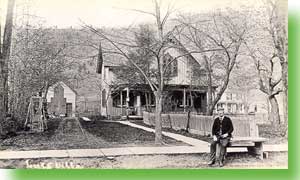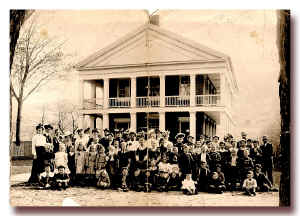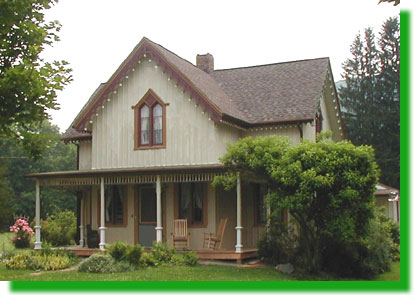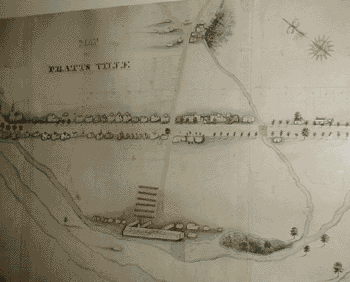Rev.Smith announced in May 2002 that Benjamin Moore Paint Co has awarded the church a grant to paint the Old Manse
in historically correct colors. The Old Manse is of the design of A. J Downing who lived in the early 19th century.
Using color schemes suggested by Mr. Downing's book , "The Architecture of Country Houses",
a color scheme appropriate to the mid 1800's has been approved.
Work begins May with the painting to be completed by Labor Day 2002. Watch this space for pictures as the work progresses!
|

"Lutz Villa" in 1910, with Fred Lutz in the foreground
|
One of the unique old houses
in Prattsville today is known
by the local people as the Sayers Lutz House. Before the Lutz family owned it, it was called
the Old Manse.
In 1845 the Protestant
Episcopal congregation in
Prattsville built Grace Church and,
about the same time, the Manse for the minister, designed by
A.J.Downing.
The Old Manse went up on the south side of Main Street and east
of the crowded business district. From his new home, the Reverend Thomas Judd could admire the Gothic Revival style of Grace Church
located across the road, just before the bridge over
Huntersfield Creek.
|
|
If
Rev. Judd looked directly east, he could keep an eye on
the pupils at the new (1842)
Academy with its two-story wrap-around
porches.
Probably
his best view was directly across the road
where sat (since 1828) the country mansion of
Colonel Zadock Pratt, town founder and warden
(treasurer) of Grace Church.
The garden of Mrs. Pratt (Mary Watson) brightened the
neighborhood. She tended
it herself.
|

The Academy, next to the Lutz House
|
|

|
Anyone who had watched the
development of the hamlet during the previous quarter century knew
that Colonel Pratt was its moving force.
In the first place, in 1824, at thirty-four years of age, he
had picked this area of Greene Country (from several possibilities) to
set up his own tanning business.
On village land he bought, he built a straight road cutting off
the big bend in the Schoharie Creek
which the old road skirted. Along both sides
of this new road there
was room for the scores of
new buildings of every description, most of them stores and homes that
he built for his employees. Business
flourished and the population grew.
|
|
Long before the arrival of Pratt, however,
the population had been growing
from the tiny settlement in the
western reaches of the area
during the American
Revolution to several dozen families at the beginning of the
19th century.
By 1804, the consistory of the Reformed Dutch Church put up a
proper sanctuary opposite the
west end of the big bend.
Seeking
to answer the spiritual
needs of the influx of
new arrivals in the late
1820�s and early 1830�s, the
district of the Methodist Episcopal denomination provided a church building in 1835.
Soon after, in 1845, they also built the new minister's
residence, the manse.
|
Sayers Lutz
House/Old Episcopal Manse ...
... from the 1982 NY State Parks &
Preservation Building-Structure Inventory Survey of Prattsville:
"This house was originally built in the shape of a cross.
Top of the cross is front of the house. Unique molding
around house under cornice. Beautiful interior door and
window frames in two of the front rooms and hall. Circular
stairway in front hall.
One of the first residences in the mountain towns of Greene
County to be built expressly for a manse. This house is a
fine example of Gingerbread Gothic.
Built in the shape of a cross. Very similar to designs by
A.J.Downing & Davis in their publications of the mid
1800�s. This dwelling has special architectural
importance. Zadock Pratt donated money towards the
building of this house." |
|
|
Colonel Pratt�s home
was just about in the
middle of everything and at just about the middle point between the two ends of his new road .
Too, it was at the only real
�corner� in the village.
Washington Street led over the mountain toward Albany. His home commanded a view of all comings and goings.
In 2000, the Reformed
Dutch Church of Prattsville acquired the Sayers Lutz House and
converted it back into the minister's residence, a purpose for
which it was built over 150 years ago.
The first resident of the "new manse", the Rev. Dianna Smith, started as the
pastor
of the Reformed Dutch Church since 2001.
Go to the Top
|

|
This history feature
is written by Muriel Pons, Prattsville Town Historian and a past
President of the Zadock Pratt Museum.
Muriel Pons lives in Prattsville and is planning to do more research
this year to fill in the history features of interest to Prattsville
and the Northern Catskills. You can reach her at: MurielPons@hotmail.com
|
|
|